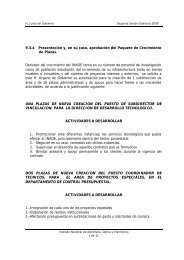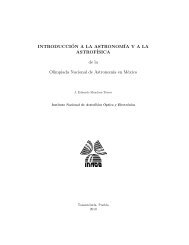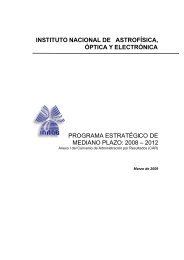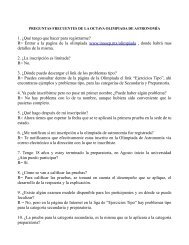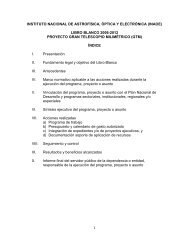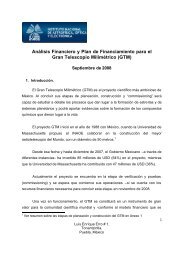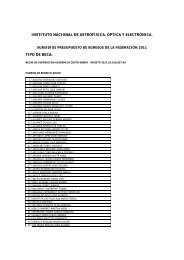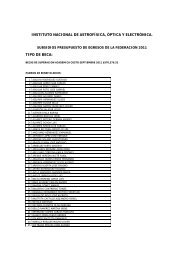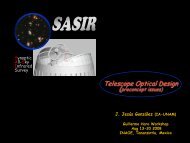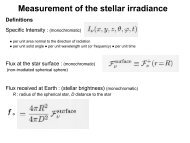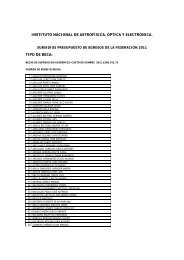Fully adaptable band-stop filter using varactor diodes - inaoe
Fully adaptable band-stop filter using varactor diodes - inaoe
Fully adaptable band-stop filter using varactor diodes - inaoe
You also want an ePaper? Increase the reach of your titles
YUMPU automatically turns print PDFs into web optimized ePapers that Google loves.
FULLY ADAPTABLE BAND-STOP FILTER<br />
USING VARACTOR DIODES<br />
Carles Musoll-Anguiano, 1 Ignacio Llamas-Garro, 1<br />
Zabdiel Brito-Brito, 1 Lluis Pradell, 1 and Alonso Corona-Chavez 2<br />
1 Signal Theory and Communications Department, Technical<br />
University of Catalonia, Barcelona 08034, Spain; Corresponding<br />
author: llamasi@ieee.org<br />
2 National Institute for Astrophysics, Optics and Electronics, Puebla<br />
72840, Mexico<br />
Received 2 June 2009<br />
ABSTRACT: In this article a reconfigurable <strong>band</strong>-<strong>stop</strong> <strong>filter</strong> able to<br />
reconfigure center frequency, <strong>band</strong>width, and selectivity for fine tuning<br />
applications is demonstrated, device topology discussion and<br />
implementation details are given, and followed by discussion on<br />
simulations and measurements. The reconfigurable <strong>filter</strong> topology has four<br />
poles and a quasi-elliptic <strong>band</strong>-<strong>stop</strong> <strong>filter</strong> response. The device is tuned by<br />
<strong>varactor</strong> <strong>diodes</strong> placed at different locations on the <strong>filter</strong>; <strong>varactor</strong>s are<br />
voltage controlled in pairs due to <strong>filter</strong> symmetry for center frequency and<br />
<strong>band</strong>width control. An additional <strong>varactor</strong> is placed on a crossing line to<br />
move a pair of transmission zeros, closer or farther to the <strong>filter</strong> center<br />
frequency, which tunes <strong>filter</strong> selectivity. Simulations show a tuneable<br />
center frequency range from 1.42 to 1.48 GHz, a tuneable fractional<br />
<strong>band</strong>width range from 9.46 to 12.96%, and a tuneable selectivity range<br />
from 0.53 to 0.65 dB/MHz. Measurements show a tuneable center<br />
frequency range from 1.37 to 1.43 GHz, a tuneable fractional <strong>band</strong>width<br />
range from 11.31 to 15.93%, and a selectivity tuning range from 0.37 to<br />
0.40 dB/MHz. Simulations and measurements are in good agreement.<br />
VC 2010 Wiley Periodicals, Inc. Microwave Opt Technol Lett 52: 554–558,<br />
2010; Published online in Wiley InterScience (www.interscience.<br />
wiley.com). DOI 10.1002/mop.24969<br />
Key words: continuously tuned <strong>filter</strong>; <strong>band</strong>-<strong>stop</strong> quasi-elliptic <strong>filter</strong>;<br />
<strong>varactor</strong> diode; reconfigurable <strong>filter</strong>; transmission zeros<br />
1. INTRODUCTION<br />
There is an increased demand for microwave <strong>filter</strong>s with<br />
advanced features that can make radio frequency (RF) systems<br />
much more efficient and <strong>adaptable</strong> to multiple <strong>band</strong>s. Reconfigurable<br />
<strong>filter</strong>s can reduce the complexity of a system avoiding<br />
the introduction of <strong>filter</strong> banks; the <strong>filter</strong> presented in this article<br />
finds its application in <strong>adaptable</strong> image rejection receivers. Earlier<br />
work has been primarily focused on center frequency or<br />
<strong>band</strong>width control [1–8]. Filter parameters like center frequency<br />
or <strong>band</strong>width can be controlled continuously, discretely, or a<br />
combination of both. Continuously tuned <strong>filter</strong>s have been<br />
implemented <strong>using</strong> <strong>varactor</strong> <strong>diodes</strong> [9–15], MEMS <strong>varactor</strong>s<br />
[16–20], or ferroelectric materials [21–24]. On the other hand,<br />
discretely tuned <strong>filter</strong>s have been implemented <strong>using</strong> PIN <strong>diodes</strong><br />
[25–31] or MEMS switches [32–34]. The <strong>band</strong>-<strong>stop</strong> <strong>filter</strong> in Ref.<br />
[35] uses PIN <strong>diodes</strong> to control <strong>filter</strong> center frequency discretely,<br />
meanwhile <strong>varactor</strong> <strong>diodes</strong> provide a continuous <strong>band</strong>width<br />
reconfiguration at a given frequency. The <strong>filter</strong> presents discrete<br />
center frequencies in the range from 0.5 to 2 GHz, and continuous<br />
<strong>band</strong>width reconfiguration in the range from 30 to 42%. In<br />
Ref. [36], a switchable <strong>band</strong>-<strong>stop</strong> <strong>filter</strong> with two different center<br />
frequencies is presented; the <strong>filter</strong> topology allows precise control<br />
over frequency and <strong>band</strong>width discretely, achieved by<br />
choosing resonator sections switched by PIN <strong>diodes</strong>. In this article,<br />
we propose selectivity tuning in addition to center frequency<br />
and <strong>band</strong>width reconfigurability, <strong>using</strong> a quasi-elliptic <strong>band</strong>-<strong>stop</strong><br />
<strong>filter</strong> response; selectivity tuning is achieved in a <strong>band</strong>-<strong>stop</strong> <strong>filter</strong><br />
response for the first time by the authors as compared to previous<br />
work in Ref. [1] and [11]. The <strong>filter</strong> is capable of having<br />
different center frequency states with precise <strong>band</strong>width control,<br />
or alternatively having different fractional <strong>band</strong>widths with a<br />
fixed center frequency. Moreover, the <strong>filter</strong> allows selectivity<br />
tuning for each state. All <strong>filter</strong> parameters are tuned continuously.<br />
In this article, a discussion on the <strong>filter</strong> topology and its<br />
implementation, including a thorough comparison between simulations<br />
and measurements on <strong>filter</strong> performance, has been added<br />
compared to previous work [37].<br />
2. BAND-STOP FILTER TOPOLOGY<br />
The <strong>filter</strong> is designed to have a quasi-elliptic <strong>band</strong>-<strong>stop</strong> <strong>filter</strong><br />
response, having one pair of transmission zeros at finite frequencies.<br />
The transmission zeros have been achieved by a cross-coupling<br />
line between a pair of nonadjacent resonators. The simulated<br />
[38] comparison between a Chebyshev and quasi-elliptic<br />
<strong>filter</strong> response is shown in Figure 1. The Chebyshev response is<br />
achieved by having a <strong>filter</strong> topology without the crossing line<br />
between nonadjacent resonators [1]. The quasi-elliptic <strong>band</strong>-<strong>stop</strong><br />
ladder network of the proposed <strong>filter</strong> is shown in Figure 2. By<br />
varying the coupling capacitances C i between the main transmission<br />
line and each resonator, the <strong>band</strong>width of the <strong>filter</strong> can be<br />
modified. The series LC models transmission line resonators are<br />
loaded by capacitances C j on one end. By varying C j , the <strong>filter</strong><br />
center frequency can be modified. By varying the cross coupling<br />
capacitance between nonadjacent resonators, C k , the <strong>filter</strong> selectivity<br />
can be modified.<br />
The design of the reconfigurable four pole quasi-elliptic <strong>band</strong><strong>stop</strong><br />
<strong>filter</strong> starts with a low-pass quasi-elliptic prototype <strong>filter</strong><br />
[39]. It is well known that an element transformation of the lowpass<br />
element values and frequency mapping produces the desired<br />
theoretical <strong>filter</strong> response [39]. Through this method the values of<br />
C i , L, and C resonator can be determined, where C resonator ¼ (C <br />
C j )/(C þ C j ) (Fig. 2). The <strong>filter</strong> was initially designed to have a<br />
center frequency at 1.41 GHz, with a 15% fractional <strong>band</strong>width.<br />
Varactor <strong>diodes</strong> were then inserted on the <strong>filter</strong> topology to tune<br />
<strong>filter</strong> parameters. The quasi-elliptic low-pass prototype elements<br />
used for the proposed <strong>filter</strong> are given in Table 1.<br />
In Table 1, X a is the attenuation pole frequency, g 1 and g 2<br />
are the low-pass elements for the first and second resonator of<br />
the <strong>filter</strong>. Only half of the values are given due to <strong>filter</strong> symmetry.<br />
An immittance inverter J a is located between resonators 2<br />
and 3 (Fig. 2). The immittance inverter J b corresponds to the<br />
Figure 1 Comparison between a Chebyshev and a quasi-elliptic ban<strong>stop</strong><br />
<strong>filter</strong> response. [Color figure can be viewed in the online issue,<br />
which is available at www.interscience.wiley.com]<br />
554 MICROWAVE AND OPTICAL TECHNOLOGY LETTERS / Vol. 52, No. 3, March 2010 DOI 10.1002/mop
Figure 2<br />
Quasi-elliptic <strong>band</strong>-<strong>stop</strong> <strong>filter</strong> ladder network<br />
Figure 3<br />
<strong>diodes</strong><br />
Reconfigurable quasi-elliptic <strong>band</strong>-<strong>stop</strong> <strong>filter</strong> <strong>using</strong> <strong>varactor</strong><br />
cross coupling between nonadjacent resonators 1 and 4 (Fig. 2);<br />
J a and J b have opposite signs, and hence, the cross coupling line<br />
has an electrical length of 270 . From Table 1, the impedance<br />
of the line between resonators 2 and 3 in Figure 2 is around 50<br />
X. Similarly the impedance of the crossing line between resonators<br />
1 and 4 in Figure 2 is found to be Z b ¼ 250 X. As a 250 X<br />
line is impractical for fabrication <strong>using</strong> conventional photolithography,<br />
two h/2 line sections connected by a series capacitor<br />
C k , as shown in Figure 2 were used instead. To find the value of<br />
capacitor C k , first the line length h is chosen to give a value of<br />
admittance Y b from (1) that corresponds to a 65 X impedance<br />
line suitable for realization <strong>using</strong> a conventional photolithographic<br />
process. Then, the value of C k can be calculated <strong>using</strong><br />
(2), where Z 0 is the characteristic impedance of the line and f 0<br />
is the <strong>filter</strong> center frequency. Using (2), C k was calculated to be<br />
0.3pF, where h in (1) was taken as 120 .<br />
3. FILTER IMPLEMENTATION<br />
J b<br />
Y b ¼ <br />
tan h (1)<br />
2<br />
J b<br />
C k ¼ 2<br />
(2)<br />
J<br />
2pf 0 Z 0 1 b<br />
Y b<br />
This section describes <strong>filter</strong> layout implementation, including<br />
bias circuitry, details of the surface mount components used,<br />
and substrate characteristics. Figure 3 shows the proposed <strong>filter</strong><br />
topology layout that consists of a main transmission line with<br />
four transmission line resonators loaded with <strong>varactor</strong> <strong>diodes</strong> C j<br />
on one end; these transmission line resonators correspond to the<br />
LC resonator model in Figure 2. Filter center frequency control<br />
can be attained by modifying the capacitance value of C j . These<br />
resonators are coupled to the main transmission line through<br />
<strong>varactor</strong> diode C i destined to control the fractional <strong>band</strong>width of<br />
the <strong>filter</strong>. Selectivity tuning was achieved by <strong>varactor</strong> diode C k<br />
in the middle of the crossing line that produces the cross coupling<br />
between nonadjacent resonators (Figs. 2 and 3). Changing<br />
the capacitance of C k varies the electrical length of the line and<br />
TABLE 1<br />
Quasi-Elliptic Low-pass Prototype Element Values<br />
X a g 1 g 2 J a J b<br />
1.85 0.95 1.41 1.10 0.19<br />
hence, the position of the transmission zeros located around the<br />
<strong>stop</strong>-<strong>band</strong> <strong>filter</strong>.<br />
The <strong>filter</strong> was defined photolithographically on a Rogers<br />
Duroid substrate (e r ¼ 2.2 and tand ¼ 0.0009). The RF choke<br />
consists of a 177 nF inductor from Tyco Electronics with a selfresonance<br />
at 1.7 GHz. The choke inductor has been modeled as<br />
a 177 nF inductor in parallel with a 50 fF capacitor. Although<br />
the initial <strong>filter</strong> center frequency is around 1.4 GHz, the inductor<br />
isolation is better than 35 dB within the <strong>filter</strong> operation frequency<br />
range. Due to the high isolation of the choke inductor,<br />
the microwave signal is not influenced by the DC ports used to<br />
provide bias to the active devices.<br />
To prevent a short circuit between the main transmission line<br />
and the crossing line, a DC block has been inserted on the<br />
crossing line, as shown in Figure 3. The DC block used was a 1<br />
nF capacitor.<br />
Three DC sources in Figure 3 were used to tune the three <strong>filter</strong><br />
design parameters. V k controls <strong>filter</strong> selectivity, V i controls<br />
<strong>filter</strong> <strong>band</strong>width, and V j controls <strong>filter</strong> center frequency. These<br />
DC sources supply the reverse voltage needed to bias the <strong>varactor</strong><br />
<strong>diodes</strong>. The grey zone in Figure 3 has positive polarization,<br />
and the black one has negative polarization. The <strong>varactor</strong>s were<br />
biased <strong>using</strong> a voltage ranging from 0 to 20 V according to the<br />
manufacturer’s data sheet.<br />
MACOM <strong>varactor</strong> <strong>diodes</strong> MA46470-276 were used for C k<br />
and C i , and MA4ST402-287 were used for C j . The MA46470-<br />
276 <strong>diodes</strong> have a capacitance range from 0.3 to 1.8 pF, and the<br />
MA4ST402-287 <strong>diodes</strong> have a capacitance range from 3.86 to<br />
86.29 pF. A photograph of the fabricated <strong>filter</strong> is shown in<br />
Figure 4.<br />
4. RESULTS<br />
This section contains simulated and measured results obtained<br />
from the proposed <strong>filter</strong>. The section is divided into three parts;<br />
Section 4.1 shows the results for center frequency tuning. Section<br />
4.2 describes the results for <strong>band</strong>width tuning. Finally, Section<br />
4.3 shows the results obtained when selectivity is tuned.<br />
Simulated results were obtained <strong>using</strong> commercial software [38]<br />
to do electromagnetic simulations taking into account the surface<br />
mount component’s lumped element models. All measurements<br />
were done after a short-open-load-thru calibration, setting<br />
the measurement reference plane at the SMA coaxial connectors<br />
used to interface the <strong>filter</strong> with the measurement equipment.<br />
Scattering parameters were measured <strong>using</strong> an Agilent 8510C<br />
network analyzer, DC bias was supplied by two Promax FAC-<br />
662B power supplies.<br />
DOI 10.1002/mop MICROWAVE AND OPTICAL TECHNOLOGY LETTERS / Vol. 52, No. 3, March 2010 555
TABLE 2 Comparison Between Simulation and Measurement<br />
Results for Filter Centre Frequency Tuning<br />
Simulation<br />
Measurement<br />
State f 0 (GHz) FBW(%) f 0 (GHz) FBW(%)<br />
(a) 1.42 14.31 1.37 15.54<br />
(b) 1.45 14.10 1.39 15.56<br />
(c) 1.46 13.98 1.41 14.92<br />
(d) 1.48 13.62 1.43 13.63<br />
f 0 range tuning: 60 MHz f 0 range tuning: 60 MHz<br />
Figure 4 Photograph of the reconfigurable quasi-elliptic <strong>band</strong>-<strong>stop</strong> <strong>filter</strong>.<br />
[Color figure can be viewed in the online issue, which is available at<br />
www.interscience.wiley.com]<br />
4.1. Center Frequency Tuning<br />
In simulations [38], C k was fixed to 0.35 pF and C i was fixed to<br />
1.1 pF to tune <strong>filter</strong> center frequency. To tune <strong>filter</strong> center frequency,<br />
the capacitances of <strong>varactor</strong> <strong>diodes</strong> C j were varied from<br />
5.6 to 8.1 pF. A center frequency tuning of 60 MHz was<br />
achieved within this capacitance range, as shown in the upper<br />
part of Figure 5.<br />
To obtain the <strong>filter</strong> tuneable center frequency, the reverse<br />
voltage V k was fixed to 15 V, V i was fixed to 2 V, and V j varied<br />
between 16 and 21 V. The <strong>varactor</strong> <strong>diodes</strong> C j were reverse-biased<br />
by V j , which adjusts the resonator electrical lengths to produce<br />
the reconfigurable <strong>filter</strong> center frequency as shown in the<br />
lower part of Figure 5. The center frequency is tuned from 1.37<br />
to 1.43 GHz <strong>using</strong> bias voltages from 16 to 21 V, respectively.<br />
A comparison between simulated and measured responses of the<br />
<strong>filter</strong> when tuning <strong>filter</strong> center frequency is shown in Table 2,<br />
where a very good agreement between simulations and measurements<br />
was obtained.<br />
4.2. Bandwidth Tuning<br />
In simulations [38], <strong>band</strong>width tuning was controlled by C i ,<br />
which modifies the resonator capacitive coupling from the main<br />
transmission line. This produces an additional variation of <strong>filter</strong><br />
center frequency, due to the fact that varying C i will slightly<br />
capacitively load the resonators. Therefore, C j was slightly<br />
modified to readjust the electrical length of the resonators to<br />
provide a fixed <strong>filter</strong> center frequency at 1.46 GHz, while <strong>filter</strong><br />
<strong>band</strong>width was tuned. In simulations, C i varied between 0.8 and<br />
1.1 pF to reach a fractional <strong>band</strong>width range from 9.46 to<br />
12.93%, C k was fixed to 0.35 pF for all states. The simulated<br />
response for the <strong>filter</strong> is shown in the upper part of Figure 6.<br />
In the measurement setup, V i and V j were varied simultaneously,<br />
whereas V k is fixed to 15 V. V i sets the capacitance of C i<br />
<strong>using</strong> a reverse voltage ranging from 2 to 5 V. Simultaneously,<br />
the DC source V j adjusts the capacitance of C j <strong>using</strong> a reverse<br />
voltage ranging from 14.1 to 20 V to maintain a fixed <strong>filter</strong> center<br />
frequency. The lower part of Figure 6 shows the measured<br />
response for the <strong>filter</strong> when <strong>band</strong>width is tuned. The tuneable<br />
fractional <strong>band</strong>width obtained for the <strong>filter</strong> ranges from 11.31 to<br />
15.93%.<br />
A comparison between simulations and measurements for <strong>filter</strong><br />
<strong>band</strong>width tuning is given in Table 3, where a very good<br />
agreement between simulations and measurements was obtained.<br />
4.3. Selectivity Tuning<br />
The simulated [38] response when tuning selectivity for the <strong>filter</strong><br />
is shown in the upper part of Figure 7. First, <strong>band</strong>width and center<br />
frequency are fixed, maintaining C i ¼ 1.1 pF and C j ¼ 5.8<br />
pF and then different values of selectivity are taken by varying<br />
the capacitance of <strong>varactor</strong> diode C k from 0.3 to 0.6 pF. Selectivity<br />
tuning is independent from the other design parameters.<br />
To calculate the selectivity for each <strong>filter</strong> state, we have taken<br />
the slope at the most linear part of the <strong>filter</strong> response in the<br />
pass<strong>band</strong> to <strong>stop</strong><strong>band</strong> transition region. The most linear region<br />
Figure 5 Simulated and measured results for the <strong>band</strong>-<strong>stop</strong> <strong>filter</strong> with<br />
center frequency control (upper part: simulated response, lower part:<br />
measured response). [Color figure can be viewed in the online issue,<br />
which is available at www.interscience.wiley.com]<br />
Figure 6 Simulated and measured results for the <strong>band</strong>-<strong>stop</strong> <strong>filter</strong> with<br />
<strong>stop</strong><strong>band</strong> <strong>band</strong>width control (upper part: simulated response, lower part:<br />
measured response). [Color figure can be viewed in the online issue,<br />
which is available at www.interscience.wiley.com]<br />
556 MICROWAVE AND OPTICAL TECHNOLOGY LETTERS / Vol. 52, No. 3, March 2010 DOI 10.1002/mop
TABLE 3 Comparison between Simulation and Measurement<br />
Results for Filter Bandwidth Tuning<br />
Simulation<br />
Measurement<br />
State FBW(%) f 0 (GHz) FBW(%) f 0 (GHz)<br />
(a) 12.96 1.47 15.93 1.43<br />
(b) 11.86 1.46 13.29 1.42<br />
(c) 10.65 1.46 11.97 1.42<br />
(d) 9.46 1.46 11.31 1.42<br />
Total fractional<br />
Total fractional<br />
<strong>band</strong>width variation: 3.50% <strong>band</strong>width variation: 4.62%<br />
TABLE 4 Comparison between Simulation and Measurement<br />
Result for Filter Selectivity Tuning<br />
Simulation<br />
Measurement<br />
State<br />
Sel. (dB/MHz)<br />
Sel. (dB/MHz)<br />
(a) 0.65 0.40<br />
(b) 0.64 0.39<br />
(c) 0.63 0.38<br />
(d) 0.58 0.38<br />
(e) 0.53 0.37<br />
Selectivity tuning<br />
range: 0.12 dB/MHz<br />
Selectivity tuning range:<br />
0.03 dB/MHz<br />
was found to be between 5 and 10 dB. A selectivity tuning<br />
range from 0.53 to 0.65 dB/MHz has been obtained.<br />
In the lower part of Figure 7, <strong>filter</strong> selectivity tuning measurements<br />
are shown. The most linear part of the <strong>filter</strong> response<br />
in the pass<strong>band</strong> to <strong>stop</strong><strong>band</strong> transition was chosen to calculate<br />
the slope and found to be between 5 and 10 dB. Varactor<br />
diode C k is reverse-biased by V k to produce a selectivity variation<br />
from 0.37 to 0.40 dB/MHz, whereas V i and V j are fixed to<br />
2 and 20 V, respectively. The reverse voltage of V k ranges from<br />
2 to 20 V. A higher variation in selectivity was observed when<br />
the bias voltage values were in the range from 15 to 20 V.<br />
Within these voltage bias values, the capacitance of the <strong>varactor</strong><br />
diode is smaller. Therefore, as the reverse voltage increases, the<br />
capacitance values decrease and <strong>filter</strong> selectivity becomes lower.<br />
Table 4 contains a comparison of simulated and measured<br />
results for selectivity tuning. The measured selectivity tuning<br />
range was limited by the parasitic capacitance of the <strong>varactor</strong><br />
diode mount, including solder pads and solder that added up to<br />
the <strong>varactor</strong> diode C k capacitance; this displaced the overall capacitance<br />
value outside the values that would give a maximum<br />
selectivity tuning. Although selectivity tuning has been successfully<br />
demonstrated, higher values of measured selectivity tuning<br />
can be obtained by accurately modeling the <strong>varactor</strong> diode<br />
mount to account for capacitive parasitic effects that can affect<br />
the overall value of C k calculated from (2).<br />
5. CONCLUSIONS<br />
Figure 7 Simulated and measured results for the <strong>band</strong>-<strong>stop</strong> <strong>filter</strong> with<br />
selectivity control (upper part: simulated response, lower part: measured<br />
response). [Color figure can be viewed in the online issue, which is<br />
available at www.interscience.wiley.com]<br />
A reconfigurable <strong>band</strong>-<strong>stop</strong> <strong>filter</strong> with a pair of transmission zeros<br />
has been proposed and successfully demonstrated. A careful<br />
comparison between simulations and measurements has been<br />
carried out to validate the design theory and implementation. Selectivity<br />
tuning for the <strong>filter</strong> has been obtained by varying the<br />
capacitance of a <strong>varactor</strong> diode situated on the crossing line that<br />
produces the cross-coupled circuit. Bandwidth tuning has been<br />
controlled by <strong>varactor</strong> <strong>diodes</strong> used to couple resonators to the<br />
main transmission line. The center frequency of the <strong>filter</strong> is controlled<br />
by <strong>varactor</strong> <strong>diodes</strong> placed at the end of transmission line<br />
resonators. The <strong>filter</strong> topology presented in this article is able to<br />
tune all <strong>filter</strong> design parameters continuously and can be perfectly<br />
adjusted to produce a fractional <strong>band</strong>width range from<br />
11.51 to 15.46%, a center frequency range from 1.34 to 1.42<br />
GHz, and a selectivity tuning range from 0.37 to 0.40 dB/MHz.<br />
ACKNOWLEDGMENTS<br />
This work has been financed by research project TEC2007-65705/<br />
TCM from the Spanish Ministry of Education and Culture.<br />
REFERENCES<br />
1. I.C. Hunter and J.D. Rhodes, Electronically tunable microwave<br />
<strong>band</strong><strong>stop</strong> <strong>filter</strong>s, IEEE Trans Microwave Theory Tech 30 (1982),<br />
1361–1367.<br />
2. S.R. Chandler, I.C. Hunter, and J.G. Gardiner, Active <strong>varactor</strong> tunable<br />
microwave <strong>filter</strong>s, Proceedings of 23rd European Microwave<br />
Conference, 1993, pp. 244–245.<br />
3. H. Uchida, A. Sato, A. Ohno, N. Yoneda, Y. Konishi, and S.<br />
Makino, A widely-tunable balanced <strong>band</strong><strong>stop</strong> <strong>filter</strong> with low reflections<br />
and separate <strong>stop</strong>- <strong>band</strong>s, Proceedings of Asia-Pacific Microwave<br />
Conference, 2006, Yokohama, Japan, pp. 641–644.<br />
4. X.-H. Wang, B.-Z. Wang, H. Zhang, and K.J. Chen, A tunable<br />
<strong>band</strong><strong>stop</strong> resonator based on a compact slotted ground structure,<br />
IEEE Trans Microwave Theory Tech 55 (2007), 1912–1918.<br />
5. W.D. Yan and R.R. Mansour, Compact tunable <strong>band</strong><strong>stop</strong> <strong>filter</strong> integrated<br />
with large deflected actuators, IEEE MTT-S International<br />
Microwave Symposium, Honolulu, HI, 2007, pp. 1611–1614.<br />
6. M.F. Karim, A.Q. Liu, A.B. Yu, and A. Alphones, MEMS-based<br />
tunable <strong>band</strong><strong>stop</strong> <strong>filter</strong> <strong>using</strong> electromagnetic <strong>band</strong>gap (EBG) structures,<br />
Proc Asia-Pacific Microwave Conf 3 (2005), 4.<br />
7. G. Zheng and J. Papapolymerou, Monolithic reconfigurable <strong>band</strong><strong>stop</strong><br />
<strong>filter</strong> <strong>using</strong> RF MEMS switches, Int J RF Microwave Comput<br />
Aided Eng 14 (2004), 373–382.<br />
8. A. Takacs, D. Neculoiu, D. Vasilache, A. Muller, P. Pons, H.<br />
Aubert, and R. Plana, Tunable MEMS <strong>filter</strong>s for millimeter wave<br />
applications, Proc Int Semiconductor Conf 1 (2006), 115–118.<br />
9. C.-K. Liao, C.-Y. Chang, and J. Lin, A reconfigurable <strong>filter</strong> based<br />
on doublet configuration, IEEE MTT-S International Microwave<br />
Symposium, Honolulu, HI, 2007, pp. 1607–1610.<br />
10. M.-S. Chung, I.-S. Kim, and S.-W. Yun, Varactor-tuned hairpin<br />
<strong>band</strong>pass <strong>filter</strong> with an attenuation pole, Proc Asia-Pacific Microwave<br />
Conf 4 (2005), 4.<br />
11. I.C. Hunter and J.D. Rhodes, Electronically tunable microwave<br />
<strong>band</strong>pass <strong>filter</strong>s, IEEE Trans Microwave Theory Tech 9 (1982),<br />
1354–1360.<br />
DOI 10.1002/mop MICROWAVE AND OPTICAL TECHNOLOGY LETTERS / Vol. 52, No. 3, March 2010 557
12. M. Sanchez-Renedo, R. Gomez-Garcia, J.I. Alonso, and C. Briso-<br />
Rodriguez, Tunable combline <strong>filter</strong> with continuous control of center<br />
frequency and <strong>band</strong>width, IEEE Trans Microwave Theory Tech<br />
53 (2005), 191–199.<br />
13. M. Makimoto and M. Sagawa, Varactor tuned <strong>band</strong>pass <strong>filter</strong>s<br />
<strong>using</strong> microstrip-line ring resonators, IEEE MTT-S Int Microwave<br />
Symp 86 (1986), 411–414.<br />
14. A.R. Brown and G.M. Rebeiz, A <strong>varactor</strong>-tuned RF <strong>filter</strong>, IEEE<br />
Trans Microwave Theory Tech 48 (2000), 1157–1160.<br />
15. X.-P. Liang and Y. Zhu, Hybrid resonator microstrip line electrically<br />
tunable <strong>filter</strong>, IEEE MTT-S Int Microwave Symp 3 (2001),<br />
1457–1460.<br />
16. A. Abbaspour-Tamijani, L. Dussopt, and G.M. Rebeiz, Miniature<br />
and tunable <strong>filter</strong>s <strong>using</strong> MEMS capacitors, IEEE Trans Microwave<br />
Theory Tech 51 (2003), 1878–1885.<br />
17. E. Fourn, C. Quendo, E. Rius, A. Pothier, P. Blondy, C. Champeaux,<br />
J.C. Orlianges, A. Catherinot, G. Tanne, C. Person, and F.<br />
Huret, Bandwidth and central frequency control on tunable <strong>band</strong>pass<br />
<strong>filter</strong> by <strong>using</strong> MEMS cantilevers, IEEE MTT-S Int Microwave<br />
Symp 1 (2003), 523–526.<br />
18. D. Mercier, J.-C. Orlianges, T. Delage, C. Champeaux, A. Catherinot,<br />
D. Cros, and P. Blondy, Millimeter-wave tune-all <strong>band</strong>pass <strong>filter</strong>s,<br />
IEEE Trans Microwave Theory Tech 52 (2004), 1175–1181.<br />
19. J.-M. Kim, S. Lee, J.-H. Park, J.-M. Kim, C.-W. Baek, Y. Kwon,<br />
and Y.-K. Kim, Low loss K-<strong>band</strong> tunable <strong>band</strong>pass <strong>filter</strong> <strong>using</strong><br />
micromachined variable capacitors, Proc Int Conf on Solid-State<br />
Sensors, Actuators Microsyst 1 (2005), 1071–1074.<br />
20. M.J. Prest, Y. Wang, F. Huang, and M.J. Lancaster, Silicon combdrive<br />
actuators for low-temperature tuning of superconducting<br />
microwave circuits, J Micromech Microeng 18 (2008), 7.<br />
21. Y.-H. Chun, J.-S. Hong, P. Bao, T.J. Jackson, and M.J. Lancaster,<br />
BST <strong>varactor</strong> tuned <strong>band</strong><strong>stop</strong> <strong>filter</strong> with slotted ground structure,<br />
IEEE MTT-S International Microwave Symposium, Atlanta, GA,<br />
2008, pp. 1115–1118.<br />
22. G. Sanderson, A.H. Cardona, T.C. Watson, D. Chase, M.M. Roy,<br />
J.M. Paricka, and R.A. York, Tunable IF <strong>filter</strong> <strong>using</strong> thin-film BST<br />
<strong>varactor</strong>s, IEEE MTT-S International Microwave Symposium,<br />
2007, pp. 679–682.<br />
23. J. Nath, D. Ghosh, J.-P. Maria, A.I. Kingon, W. Fathelbab, P.D. Franzon,<br />
and M.B. Steer, An electronically tunable microstrip <strong>band</strong>pass<br />
<strong>filter</strong> <strong>using</strong> thin-film Barium-Strontium-Titanate (BST) <strong>varactor</strong>s,<br />
IEEE Trans Microwave Theory Tech 53 (2005), 2707–2712.<br />
24. Y.-H. Chun, J.-S. Hong, P. Bao, T.J. Jackson, and M.J. Lancaster,<br />
BST-<strong>varactor</strong> tunable dual-mode <strong>filter</strong> <strong>using</strong> variable zc transmission<br />
line, IEEE Microwave Wireless Compon Lett 18 (2008),<br />
167–169.<br />
25. C. Lugo and J. Papapolymerou, Electronic switchable <strong>band</strong>pass <strong>filter</strong><br />
<strong>using</strong> PIN <strong>diodes</strong> for wireless low cost system-on-a-package<br />
applications IEEE Proc Microwave Antennas Propag 151 (2004),<br />
497–502.<br />
26. M. Koochakzadeh and A. Abbaspour-Tamijani, Switchable <strong>band</strong>pass<br />
<strong>filter</strong> for 0.3–0.6 GHz, IEEE MTT-S International Microwave<br />
Symposium, 2007, pp. 557–560.<br />
27. C. Rauscher, Reconfigurable <strong>band</strong>pass <strong>filter</strong> with a three-to-one<br />
switchable pass<strong>band</strong> width, IEEE Trans Microwave Theory Tech<br />
51 (2003), 573–577.<br />
28. C. Lugo and J. Papapolymerou, Six-state reconfigurable <strong>filter</strong> structure<br />
for antenna based systems, IEEE Trans Antennas Propag 54<br />
(Part 1), (2006), 479–483.<br />
29. F. Mahe, G. Tanne, E. Rius, C. Person, S. Toutain, F. Biron, L.<br />
Billonnet, B. Jarry, and P. Guillon, Electronically switchable dual<strong>band</strong><br />
microstrip interdigital <strong>band</strong>pass <strong>filter</strong> for multistandard communication<br />
applications, Proceedings of the 30th European Microwave<br />
Conference, Paris, France, October 2000, 4 pp.<br />
30. C. Lugo and J. Papapolymerou, Single switch reconfigurable <strong>band</strong>pass<br />
<strong>filter</strong> with variable <strong>band</strong>width <strong>using</strong> a dual-mode triangular<br />
patch resonator, IEEE MTT-S International Microwave Symposium,<br />
Long Beach, CA, 2005, pp. 779–782.<br />
31. C. Lugo, J. Hadrick, and J. Papapolymerou, Dual mode reconfigurable<br />
<strong>filter</strong> for 3d system on package (SOP) integration, Proceedings<br />
VC<br />
of the 55th Electronic Components and Technology Conference,<br />
2005, pp. 532–535.<br />
32. C.D. Nordquist, C.L. Goldsmith, C.W. Dyck, G.M. Kraus, P.S.<br />
Finnegan, F. Austin, and C.T. Sullivan, X-<strong>band</strong> RF MEMS tuned<br />
combline <strong>filter</strong>, Electron Lett 41 (2005), 76–77.<br />
33. C.D. Nordquist, A. Muyshondt, M.V. Pack, P.S. Finnegan, C.W.<br />
Dyck, I.C. Reines, G.M. Kraus, T.A. Plut, G.R. Sloan, C.L. Goldsmith,<br />
and C.T. Sullivan, An X-<strong>band</strong> to Ku-<strong>band</strong> RF MEMS<br />
switched coplanar strip <strong>filter</strong>, IEEE Microwave Wireless Compon<br />
Lett 14 (2004), 425–427.<br />
34. A. Ocera, P. Farinelli, P. Mezzanotte, R. Sorrentino, B. Margesin,<br />
and F. Giacomozzi, A novel MEMS-tunable hairpin line <strong>filter</strong> on<br />
silicon substrate, Proceedings of the 36th European Microwave<br />
Conference, Manchester, England, 2006, pp. 803–806.<br />
35. B.E. Carey-Smith and P.A. Warr, Broad<strong>band</strong>-configurable <strong>band</strong><strong>stop</strong>-<strong>filter</strong><br />
design employing a composite tuning mechanism, IET<br />
Proc Microwaves Antennas and Propag 1 (2007), 420–426.<br />
36. Z. Brito-Brito, I. Llamas-Garro, L. Pradell, and A. Corona-Chavez,<br />
Microstrip switchable <strong>band</strong><strong>stop</strong> <strong>filter</strong> <strong>using</strong> PIN Diodes with<br />
Precise frequency and <strong>band</strong>width control, Proceedings of the 38th<br />
European Microwave Conference Amsterdam, The Netherlands,<br />
28–30 October 2008, pp. 1707–1710.<br />
37. C. Musoll-Anguiano, I. Llamas-Garro, Z. Brito-Brito, L. Pradell,<br />
and A. Corona-Chavez, Characterizing a tune all <strong>band</strong><strong>stop</strong> <strong>filter</strong>,<br />
IEEE MTT-S Int Microwave Workshop Series on Signal Integrity<br />
and High-Speed Interconnects, Guadalajara, Mexico, 19–20 February<br />
2009, 4 p.<br />
38. Advanced Design System. Available at: http://www.agilent.com.<br />
39. J.-S Hong and M.J. Lancaster, Microstrip <strong>filter</strong>s for RF/microwave<br />
applications, Wiley, 2001.<br />
2010 Wiley Periodicals, Inc.<br />
WIDEBAND CROSS-COUPLED FILTER<br />
USING DEFECTED STEPPED<br />
IMPEDANCE RESONATOR<br />
Bian Wu, Xin Lai, Tao Su, and Chang-Hong Liang<br />
School of Electronic Engineering, Xidian University, Xi’an, Shaanxi<br />
710071, People’s Republic of China; Corresponding author:<br />
bwu@mail.xidian.edu.cn<br />
Received 4 June 2009<br />
ABSTRACT: A novel wide<strong>band</strong> cross-coupled <strong>band</strong>-pass <strong>filter</strong> based on<br />
defected stepped impedance resonator (DSIR) is presented in this<br />
article. Although the DSIR has opposite impedance characteristic and<br />
field distribution to the microstrip SIR, its resonant property is similar<br />
to the latter. The internal coupling coefficients of DSIRs are found to be<br />
large enough for the wide<strong>band</strong> <strong>filter</strong> design. A four-pole, cross-coupled<br />
<strong>band</strong>-pass <strong>filter</strong> with f 0 ¼ 1.6 GHz and FBW ¼ 12% is designed and<br />
fabricated <strong>using</strong> the folded DSIR. Experimental result has good<br />
agreement with the simulation. VC 2010 Wiley Periodicals, Inc.<br />
Microwave Opt Technol Lett 52: 558–561, 2010; Published online in<br />
Wiley InterScience (www.interscience.wiley.com). DOI 10.1002/<br />
mop.24972<br />
Key words: defected stepped impedance resonator (DSIR); wide<strong>band</strong>;<br />
cross-coupled; <strong>band</strong>-pass <strong>filter</strong> (BPF)<br />
1. INTRODUCTION<br />
Recent development in wireless communication system has created<br />
a need of <strong>band</strong>-pass <strong>filter</strong>s with low insertion loss as well<br />
as high out-of-<strong>band</strong> rejection. Cross-coupled <strong>filter</strong>s are widely<br />
investigated because they introduce one or more additional couplings<br />
between nonadjacent resonators and create finite transmission<br />
zeros out of the pass<strong>band</strong> [1, 2]. Furthermore, high data-<br />
558 MICROWAVE AND OPTICAL TECHNOLOGY LETTERS / Vol. 52, No. 3, March 2010 DOI 10.1002/mop



